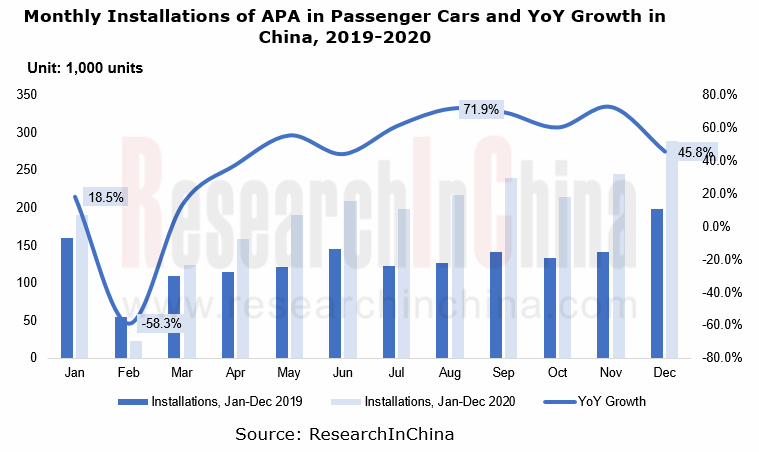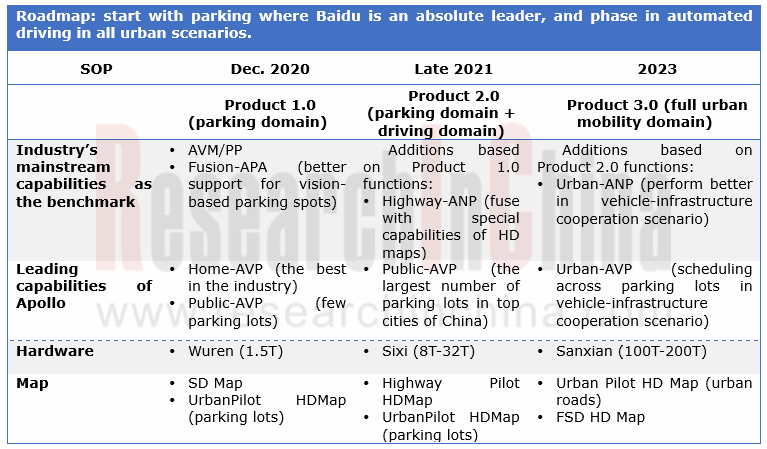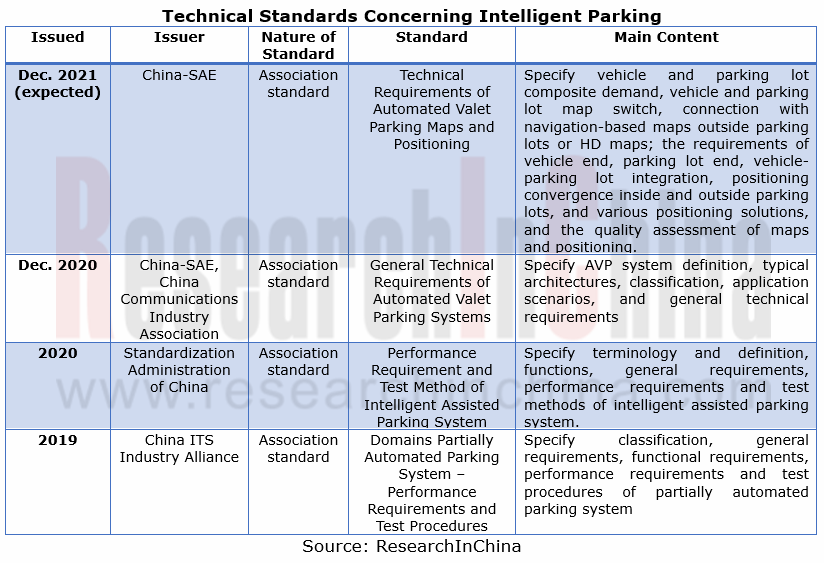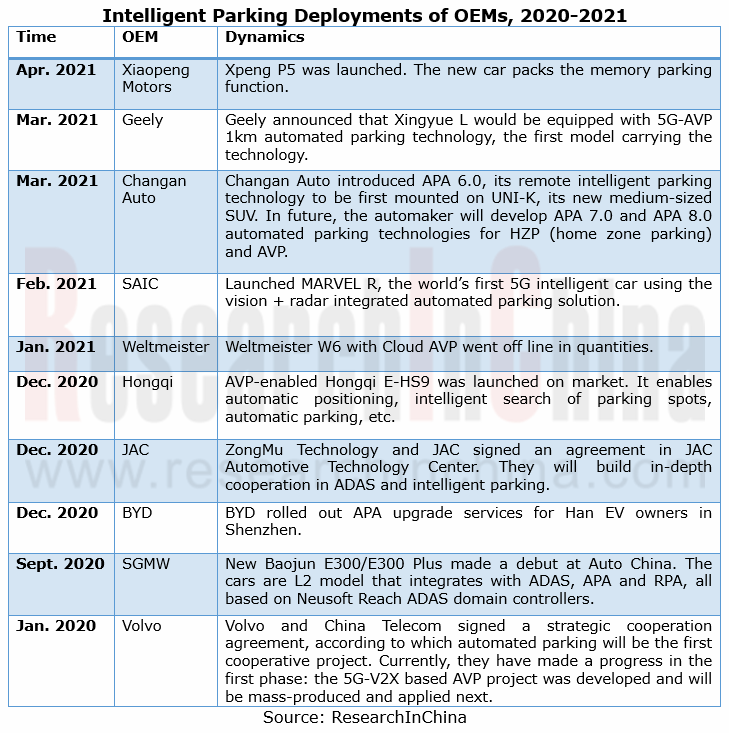Automated Parking Assist (APA) and Automated Valet Parking (AVP) Industry Report, 2021
Intelligent parking research: mass adoption of AVP will begin in 2023.
Our Automated Parking Assist (APA) and Automated Valet Parking (AVP) Industry Report, 2021 combs through technology routes, business models, products and solutions of major APA and AVP suppliers, and parking intelligence of OEMs.
In 2020, the installation rate of APA reached 12.3%, 4.28 percentage points higher than a year ago.
According to ResearchInChina, in 2020, China had 2,308,000 passenger cars equipped with APA, an annualized upsurge of 46.4%, taking the installation rate of APA to 12.3%, up 4.28 percentage points versus 2019; in 2020, the installation rate of APA made a steady growth as a whole, but a decline in February due to the reduced passenger car sales caused by the COVID-19 pandemic.

? Wherein, among APA-enabled models that sell well, most are foreign brands like Mercedes-Benz, BMW and Buick.
? Fully automated parking assist (F-APA) and remote parking are major intelligent parking system solutions at present.
? In OEM market, L3 memory parking and L4 APA capabilities begin to become available to mid-to-high-end and luxury models.
For AVP single vehicle intelligence technologies, memory parking is firstly landed; at the parking lot end, AVP is firstly used in P3 and P4 parking lots.
Automated valet parking (AVP) allows a user who gets off at the designated drop-off point to send a parking instruction via the mobile APP to his/her car which will then drive itself to the parking spot without manual operation and monitoring; as the user gives a pick-up instruction on the APP, the car following the instruction will automatically go to the designated pick-up point; if several cars receive the parking instruction at the same time, they will wait to enter the parking space one after another automatically.
The study shows that AVP that renders vehicles more intelligent can promote vehicle sales, cut down 30% operating cost for parking lots, reduce 10% invalid traffic time in parking lots, and save 10-15 minutes in vehicle pick-up and returning.
The AVP market accommodates large numbers of players which mainly provide three technology solutions: single vehicle intelligence, parking lot intelligence, and vehicle-parking lot cooperation. Of them, single vehicle intelligence primarily supplied by Baidu and ZongMu Technology are most often used by OEMs. In September 2020, at Auto China, the full-size E-HS9 SUV BEV of New Hongqi started pre-sale. This model packs AVP system from ZongMu Technology.
Baidu is a typical provider of AVP single vehicle intelligence solutions. The firm has planned the implementation route for AVP system from short distance to long distance, from easy to difficult. The memory parking (Home-AVP) is the first one to be landed.

? Home-AVP: memory parking. From elevator to parking spot, learn one time; users summon or return cars outside using their mobile phones, and their cars can drive themselves;
? Public-AVP: from any pick-up or drop-off point in the parking lot, users park their cars anywhere in the parking lot, and the cars will automatically find a parking space; the summoned cars will drive themselves to the place designated by users;
? Urban-AVP: from pick-up or drop-off point at most 1km away from the parking space to the parking space, users can summon or return their cars at their will, and the cars will drive themselves.
Bosch is a typical parking lot intelligence solution provider. Together with Mercedes-Benz and the parking lot operator Apcoa, Bosch has deployed a set of AVP system for trial commercial operation at the car park P6 at Stuttgar Airport.
Vehicle-parking lot cooperation solution providers are led by Huawei. The solution is the hardest one to be commercialized for it is difficult to coordinate multiple stakeholders involved (e.g., property companies, independent parking solution providers, OEMs, and mobility platform operators).
The General Technical Requirements of Automated Valet Parking Systems firstly defines parking lot standards.
In current stage, AVP standards are mainly formulated by associations. To fill the gaps in AVP industry standards in China and deal with the challenge of AVP compatible with multiple solutions, China-SAE and China Communications Industry Association introduced the General Technical Requirements of Automated Valet Parking Systems (T/CSAE156-2020) in December 2020.
The standard covers the three technology routes: single vehicle intelligence, parking lot intelligence and vehicle-parking lot cooperation. It has four parts of content: system definition, security application scenarios, general technical requirements of the system, and general technical requirements of testing.
The General Technical Requirements of Automated Valet Parking Systems defines levels of intelligent parking lots: P0, P1, P2, P3, P4 and P5. . On this basis, we have extended interpretation of these levels, as follows:

According to the table above, P2 parking lots meet the conditions needed by AVP single vehicle intelligence; P4 parking lots are basically qualified for being AVP parking lots at the strong end; P3 parking lots meet the conditions of AVP parking lots at the weak end, with most CVIS solutions deployed in P3 parking lots.
Most insiders argue that CVIS is the future of AVP. After exchanges with experts, we believe any technology roadmap needs a subject of responsibility for safety, that is, who takes charge of the safety of AVP system, vehicle end or parking lot end? We think the subject of responsibility at the strong end should be parking lot operators and AVP technology providers, and at the weak end, the OEMs and AVP technology providers.
Application of AVP in P2 parking lots needs L4 intelligent vehicles which are however unlikely to be mass-produced shortly (before 2025). Even if P2 parking lots are built, there will be few vehicles available. So before 2025, parking lots (P3/P4) that support CVIS solutions have plenty of room for growth.

As a substandard of the General Technical Requirements of Automated Valet Parking Systems, the Technical Requirements of Automated Valet Parking Maps and Positioning is under discussion and expected to be drafted in December 2021. The study of other AVP substandards such as AVP parking lot communications, AVP test and memory parking is in the pipeline.
OEMs step up R&D of intelligent parking systems for mass production
OEMs are accelerating R&D of intelligent parking systems for mass production by way of independently developing or seeking external collaborations. Some OEMs like Weltmeister have achieved AVP for L4 automated driving in designated scenarios through working with Baidu; Geely with 5G-AVP technology enabling 1km autonomous parking will step into exploration of intelligent cloud based AVP; with a plan of trying to equip some of its models with memory parking function in late 2020, GAC has installed AVP function in some high-end and luxury models in 2021H1; Great Wall Motor and Baidu Apollo have worked together on mass production of AVP, and announced to spawn AVP-enabled vehicles in 2021.
There is a common belief that the pace of AVP system testing will quicken to gear up for use in vehicles between 2021 and 2022, and the mass adoption of AVP system will begin in 2023.
For parking business models, parking lot operators, OEMs and AVP solution providers make profits by charging AVP subscription fee or pay-per-use billing. Parking lot operators also make benefits with value-added services derived from intelligent parking systems. An example is Bosch which combines electric vehicle automatic charging, autonomous washing of vehicles and express delivery to provide complete solutions for parking lot operators.

Autonomous Driving Domain Controller and Central Computing Unit (CCU) Industry Report, 2025
Research on Autonomous Driving Domain Controllers: Monthly Penetration Rate Exceeded 30% for the First Time, and 700T+ Ultrahigh-compute Domain Controller Products Are Rapidly Installed in Vehicles
L...
China Automotive Lighting and Ambient Lighting System Research Report, 2025
Automotive Lighting System Research: In 2025H1, Autonomous Driving System (ADS) Marker Lamps Saw an 11-Fold Year-on-Year Growth and the Installation Rate of Automotive LED Lighting Approached 90...
Ecological Domain and Automotive Hardware Expansion Research Report, 2025
ResearchInChina has released the Ecological Domain and Automotive Hardware Expansion Research Report, 2025, which delves into the application of various automotive extended hardware, supplier ecologic...
Automotive Seating Innovation Technology Trend Research Report, 2025
Automotive Seating Research: With Popularization of Comfort Functions, How to Properly "Stack Functions" for Seating?
This report studies the status quo of seating technologies and functions in aspe...
Research Report on Chinese Suppliers’ Overseas Layout of Intelligent Driving, 2025
Research on Overseas Layout of Intelligent Driving: There Are Multiple Challenges in Overseas Layout, and Light-Asset Cooperation with Foreign Suppliers Emerges as the Optimal Solution at Present
20...
High-Voltage Power Supply in New Energy Vehicle (BMS, BDU, Relay, Integrated Battery Box) Research Report, 2025
The high-voltage power supply system is a core component of new energy vehicles. The battery pack serves as the central energy source, with the capacity of power battery affecting the vehicle's range,...
Automotive Radio Frequency System-on-Chip (RF SoC) and Module Research Report, 2025
Automotive RF SoC Research: The Pace of Introducing "Nerve Endings" such as UWB, NTN Satellite Communication, NearLink, and WIFI into Intelligent Vehicles Quickens
RF SoC (Radio Frequency Syst...
Automotive Power Management ICs and Signal Chain Chips Industry Research Report, 2025
Analog chips are used to process continuous analog signals from the natural world, such as light, sound, electricity/magnetism, position/speed/acceleration, and temperature. They are mainly composed o...
Global and China Electronic Rearview Mirror Industry Report, 2025
Based on the installation location, electronic rearview mirrors can be divided into electronic interior rearview mirrors (i.e., streaming media rearview mirrors) and electronic exterior rearview mirro...
Intelligent Cockpit Tier 1 Supplier Research Report, 2025 (Chinese Companies)
Intelligent Cockpit Tier1 Suppliers Research: Emerging AI Cockpit Products Fuel Layout of Full-Scenario Cockpit Ecosystem
This report mainly analyzes the current layout, innovative products, and deve...
Next-generation Central and Zonal Communication Network Topology and Chip Industry Research Report, 2025
The automotive E/E architecture is evolving towards a "central computing + zonal control" architecture, where the central computing platform is responsible for high-computing-power tasks, and zonal co...
Vehicle-road-cloud Integration and C-V2X Industry Research Report, 2025
Vehicle-side C-V2X Application Scenarios: Transition from R16 to R17, Providing a Communication Base for High-level Autonomous Driving, with the C-V2X On-board Explosion Period Approaching
In 2024, t...
Intelligent Cockpit Patent Analysis Report, 2025
Patent Trend: Three Major Directions of Intelligent Cockpits in 2025
This report explores the development trends of cutting-edge intelligent cockpits from the perspective of patents. The research sco...
Smart Car Information Security (Cybersecurity and Data Security) Research Report, 2025
Research on Automotive Information Security: AI Fusion Intelligent Protection and Ecological Collaboration Ensure Cybersecurity and Data Security
At present, what are the security risks faced by inte...
New Energy Vehicle 800-1000V High-Voltage Architecture and Supply Chain Research Report, 2025
Research on 800-1000V Architecture: to be installed in over 7 million vehicles in 2030, marking the arrival of the era of full-domain high voltage and megawatt supercharging.
In 2025, the 800-1000V h...
Foreign Tier 1 ADAS Suppliers Industry Research Report 2025
Research on Overseas Tier 1 ADAS Suppliers: Three Paths for Foreign Enterprises to Transfer to NOA
Foreign Tier 1 ADAS suppliers are obviously lagging behind in the field of NOA.
In 2024, Aptiv (2.6...
VLA Large Model Applications in Automotive and Robotics Research Report, 2025
ResearchInChina releases "VLA Large Model Applications in Automotive and Robotics Research Report, 2025": The report summarizes and analyzes the technical origin, development stages, application cases...
OEMs’ Next-generation In-vehicle Infotainment (IVI) System Trends Report, 2025
ResearchInChina releases the "OEMs’ Next-generation In-vehicle Infotainment (IVI) System Trends Report, 2025", which sorts out iterative development context of mainstream automakers in terms of infota...